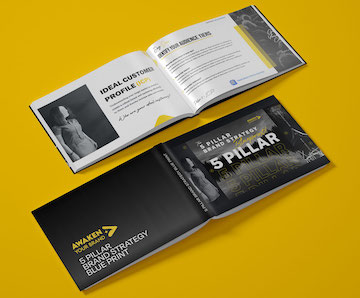Today I decided to take on a topic that is illustrative of the nature of creative services, agencies such as Spellbrand. The underline principle also applies equally well to any other kind of service oriented business or brand.
The topic is ‘Value Based Pricing’. I’ll start with an experience that I had a few days back. And the caveat to this is that by giving this example I’m not trying to belittle the person in question. However, I want to use this experience to illustrate what value-based pricing is all about and how you can implement that kind of philosophy in your own business.
So, few days back, we got an enquiry on our Spellbrand website from a wedding photographer, wanting to get a rebranding done. They have been in business for a little while, and I checked out their work and it’s fabulous work — fabulous photography of weddings, receptions and so on. They are now thinking of upgrading their brand for reaching out to more elite kind of customers. And of course, in the process charge more. Now that’s a great strategy, and you know, most businesses should be striving to do that every year or so.
When this particular enquiry came in, I reviewed the requirement, I checked out their work, and I felt that it would be a good fit for us. So, I fired off a very informal kind of proposal — a cost quotation. A little while later I got an email from this enquiry which said “well I’m new to all this, so don’t mind me asking you. You know, I’ve been looking around and I’ve been shopping around… how come your price is four or five times more than some of your competitors.” And he listed a couple of the prices for similar work — rebranding logo design particularly.
So, I looked at the question and I thought “Yeah, it’s a fantastic and it’s a valid question: Why do we charge 4 or 5, may be 6 or 7 times, more than some of the other competitors out there? Now, just step back a little bit. What I believe what we charge is quite reasonable, and, of course, you will understand what I mean in the context of this podcast. But the biggest obstacle, the biggest kind of issue, with this argument from this enquirer was the examples of the competitors that he listed were totally off. I mean those companies that he listed were overseas companies and some of them were design sweat-shops; one of them was a crowdsourcing website, and, you know, none of these are our competitors. So, I took a little while to compose a response, and email it back.
This is what I basically said and I am actually paraphrasing this. “The fact that we don’t actually price our services based on the number of hours it’d take or the time it’d take for us to do that work, or even, like some design shops might do, where they work out the costs first and then they add on some kind of a profit margin on top of the costs; instead, for the past year or so, we have been pricing our services based on the value that we would provide to our customers”.
And when I say value, I mean, if you take this example, this particular client, well… not a client, but this particular enquirer or this particular business, he’s looking to rebrand themselves so that they can change their target audience; they can change their target market from the section of the public that cannot afford to pay high prices for their wedding photographs to a part of the population that knows the importance of a wedding which you hope would happen once in your life time.
And the moments, the time… the experience of that moment to be captured in a beautiful way so that for the next few years you look back on those photographs and it brings back these sweet memories. Now and of course, on top of that they need to be able to afford paying more for that service.
Now, to do that you got to change… this business has to change how they are perceived. Their work is not going to change overnight. Their work is already on their website… great photographs, excellent work, and still, obviously, that kind of work is not fetching them the kind of revenue or the kind of fee that they deserve or more.
So, obviously, it’s not that they are going to improve their service and hence they can start charging more; rather, they would have to change the perception of how people look at them, look at their business, look at their service, look at their workmanship, and also be prepared to pay for that. In this process they would be reaching out to the kind of population that would be able to afford this. So, a change of perception really takes some thought. When you are trying to change your perception of the identity of your business or if you are trying to create a perception for the identity of your business, it’s not just about a graphic or you know, your logo or the font that you choose that is going to really make it happen. The logo, the font, the colours — they only form a part of the equation.
The bigger picture is that you need to understand who this new target market is — who the target market is, how they think, how they behave, what motivates them, and what enables them to feel that they are getting the right kind of service. So, to do that you would have to come up with creative ideas, innovative solutions that, on the face of it, might look like a simple logo that takes, I don’t know, may be three or four hours to create, but, you know, that’s far from the truth.
The three or four hours of the actual creation of a design on the computer is really nothing; it’s the tip of the iceberg. It’s the 15, 16, 17, 18 years of hard work, experience, working on fine tuning your craft…. your expertise. And then, bringing that to the table so that you can generate new ideas — ideas that will work well with your target market. So, if a business is looking to change the perception and they think that a simple logo, you know, whatever it is, just has to look good is going to cut it, then they would be in for a surprise. That’s where the ‘value based pricing’ comes in. It’s the value that we would add to the client’s business.
It’s not the graphics; it’s not the design. It’s more about the success of the brand in terms of the vision that they have. So, this would equate to, you know, a better reception by a more affluent target market — a better acceptance of the pricing, rather the increase in pricing that the brand would go through. And this takes thought; this takes experience, and, of course, this takes expertise. If you are looking for a quick logo and you want to get it done at the cheapest price possible, then, yes, of course, the company like ours is not the right fit for you.
You know, you are better off with a design sweat-shop or one of the crowd-sourcing websites where people are… designers are under tremendous pressure to produce, you know, the maximum number of designs that they can in any given day so that their chances of winning these contests increase and the chances of getting paid increase. On the other hand, the way we approach projects is that we don’t look at it as a design project; it’s more of a service where we are trying to help the client get a tremendous return on investment. So, it’s not a cost but rather an investment.
So how does this apply to your business or brand? How are you pricing your services?
Now, I will not talk about products or product based businesses because products… well, yes, you can add value to a product but you cannot really charge based on the perceived value because a product is a commodity. A service is not a commodity. Of course, services are being turned into commodities these days, but essentially a service should not be a commodity. And agencies like ours strive hard to make sure that services do not become commodities.
So, in your case, how are you pricing yourself? Are you looking at the costs of your service? That is the time and effort of yourself or may be your employees; their salaries; the overheads, the rental, you know, all that? And then you are adding a little bit on top, a percentage, may be a 10%, 20% or 30% on top of that, and that’s the price of your service; that’s the cost of your service to your customers.
Is that how you are doing it? Well, it is a great way to do the pricing, but, if you think about it, you are limiting yourself to not just about earning more revenue but about the value that you can provide to your clients because you are capping it. So, you are pricing your system based on a set of parameters, and, therefore, once you charge that, your service… what you provide to your client would be hindered… would be limited by the calculation.
You cannot go beyond that to provide a service because, you know, it would be unprofitable which means, at the end, the client really does not benefit. So, it’s not a win-win situation. It might be for a short while a win-lose situation which is you are winning but your customers are losing, a little bit. But that’s in the short term because what then happens is if you are not having profitability then you do not have the resources to try and be innovative, to try and improve your services, to try and reach new markets, better markets, and, therefore, you know, there could be a chance that the brand atrophies, and you know, a sort of dwindles down. So, having profit is very important. I wrote an article about this a little while ago and, in fact, I am going to do another podcast on profit, the importance of profit to branding.
So that’s one way. If you are charging by the hour, let’s say, you are a consultant and you are charging by the hour. That’s also good for a particular set of services and also for a particular set of circumstances. But in the long run again you are limiting yourself to the number of hours you can work and then again there is a conflict because you will try to bill as many hours as possible, whereas the client would be inclined to, you know, pay for as fewer hours as possible. So, already the relationship between you and your customer is… you know, there is a friction there. It’s not a healthy relationship. Then you come to value based pricing where you determine your pricing based on the value you are providing for the client.
If you have any questions about this or you want to discuss your pricing with me, just drop me an email or contact me through our website. And, you know, I can offer my two-cents.
Thank you so much for listening to this podcast, and till the next time, Good Bye!

